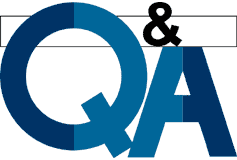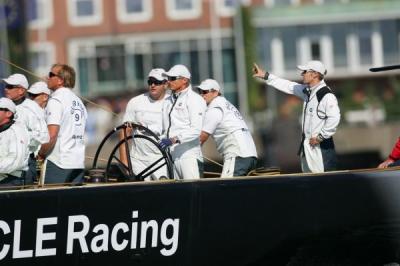Q&A #1: What's a Trim Tab? Aug 17, 09:33
 Since the outset of this campaign, our marketing department led by Mirko Groeschner, along with Judy Sim and Karen Webb of Oracle Corp, Ralf Hussmann & Co. at BMW, and latterly Bjoern Widemann at Allianz have made it a top priority to inform and entertain -- not only our VIP guests, but anyone and everyone who might be or become interested in the Cup. Chris Dickson gets it, too, and has supported these efforts more than any other Cup team leader with whom I have been involved (and that includes top guns Paul Cayard and Dennis Conner who are also savvy in this regard). With a few stubborn exceptions, the rest of our team have as well. A big and refreshing difference from the rather private affair the Cup was not too many years ago.
Since the outset of this campaign, our marketing department led by Mirko Groeschner, along with Judy Sim and Karen Webb of Oracle Corp, Ralf Hussmann & Co. at BMW, and latterly Bjoern Widemann at Allianz have made it a top priority to inform and entertain -- not only our VIP guests, but anyone and everyone who might be or become interested in the Cup. Chris Dickson gets it, too, and has supported these efforts more than any other Cup team leader with whom I have been involved (and that includes top guns Paul Cayard and Dennis Conner who are also savvy in this regard). With a few stubborn exceptions, the rest of our team have as well. A big and refreshing difference from the rather private affair the Cup was not too many years ago.(For those of you who read German, a couple days back there was a very nice article in Austria's "Der Standard" newspaper about the good job our team does helping race-day guests understand the AC -- with thanks for the tip, and article placement, to BMW's Nicole Stempinksy.)
Hence this blog. As our readership continues to grow we are finding that more and more of you following our team and "the BOB" (as some in the media now call it -- for Bmw Oracle Blog) are not necessarily sailing experts. Indeed, many of you, it turns out, are newcomers to our sport and the AC. Great!
And we get questions. Most we have answered by email, or have worked into a general post. The volume is increasng, so with this post we begin a new category, and service, here on the BOB: Q&A. You send us a question -- email it to blog[at]tfehman[dot]com -- and we try our best to answer it ASAP and ideally by an expert on our team. Fire away: no serious question will be considered too basic, or too advanced.
The question that inspired this new BOB feature came a day or so ago from a top Cup journalist, new (in AC32) to our sport. He asked:
Q: "What's a trim tab?"
A: A trim tab is a "flap" -- an adjustable surface like the flap on the trailing edge of an airplane wing -- that is attached by a hinge to the trailing edge of the keel.
When the boat tacks the tab is swung from one side to the other, around 5-12 degrees either side of centerline. This gives the keel an asymmetric shape that produces more lift. It also produces more drag, but if designed and used correctly the extra drag is more than offset by extra lift -- meaning the boat goes forward more and sideways less.
The trim tab allows a smaller keel that can produce the same lift as a bigger keel without a tab, so you don't have to drag a bigger keel downwind. Little or no trim tab is used downwind (the tab is on centerline).
If enough trim tab angle is used, an America's Cup yacht will actually make "negative leeway" -- the yacht no longer slides a bit sideways but actually "claws" to windward. This, however, usually results in a lot of exta drag.
Teams spend a fair bit of money, time and energy on the design of the keel fin and tab (to say nothing of the bulb and wings) -- trying to find the optimum size and shape overall, and best tab angles, for the various wind and sea conditions, and trimming, steering and sail combinations.
Most ACC yachts (and other classes that allow trim tabs) have an inner, smaller steering wheel to adjust the tab. Some use other means such as a rope and cleat arrangement, so the absence of an inner wheel does not necessarily mean no trim tab. An inner wheel can also be used to control a forward rudder ("canard").
--Ian "Fresh" Burns (AUS, design coordinator & sailing team)

Ian Vickers (NZL, shore team) wet sanding the keel of USA 76 during the Trapani Acts last autumn. Ian is working on the keel fin (forward); the vertical line is the slight crack between the keel fin and the trim tab on the trailing edge of the keel.

At Kiel last week, Dicko steering USA 71 with the larger wheel; the smaller, inner wheel controls the trim tab. The helmsman usually controls the trim tab as well, however in some situations the tactician does it. This photo was taken between races, and tactician Sten Mohr (DEN) is aft signalling the Chase Boat.

Today's Q&A expert: design coordinator and part-time sailing team member (navigator) Ian "Fresh" Burns -- on his fifth America's Cup campaign.
OK, so much for Q&A #1. Any comments on these (and any other posts) always appreciated. Don't hesitate to argue, politely please, with our answers, or add to them. Just click on "comment" below. Also, you can ask a new question for us there, as all comments posted are automatically forwarded to your Ed. via email.
P.S. While most do, not all ACC keels have trim tabs. Perhaps grist for a future Q&A.
Q&A | by TFE